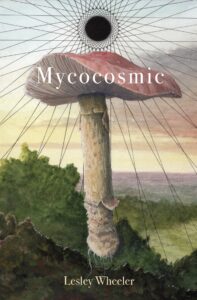 Review by Sharon Tracey
Review by Sharon Tracey
In Mycocosmic, Lesley Wheeler’s sixth poetry collection, the poet uses the metaphor of fungi to thread a masterful spell of poems that shimmer with dark energy, electricity, and transmutations as she explores childhood, family history, desire, and identity and writes her way toward both understanding and acceptance. Throughout, there’s a search for connection and a recognition of our own impermanence as the work of the natural world toils on with or without us.
Poem titles provide a sense of the ride to come. There’s “Sex Talk,” “Dark Energy,” “An Underworld,” “Flammable Almanac,” “Family Tree” and “The Underside of Everything You’ve Loved.” There are definitions and derivations. Inventive language that sings as it steams. There’s “Rhapsodomancy” and a tarot deck. There’s humor, grief, wonder, and resiliency. There’s music: “branches shushing” and “dreams grinding slow like brass gears” (9, 34).
The opening poem (3) sets the table and invites the reader in:
We Could Be
mycelial, eating toxins together,
decomposing what’s still indigestible
about this place. The singed taste.
.…
Below ground, we could grow
fat on loss, bust out in the wildest
shapes. Puffball. Flagellate.
…
It’s also the beginning of the “Underpoem [Fire Fungus], “a running footnote-poem that threads itself underneath the poems like an echo of the subconscious. Yes, the poet seems to say, we can live in two worlds at once, drawing from each, cross germinating. The underpoem plays beautifully against each poem above it, creating a disturbance with its own disturbance, as fungi do. It also creates a sense of “innerness” that doesn’t interrupt what unfolds above.
Another thematic thread is Wheeler’s interest in divinations as a way to gain insight into the unknown. Sometimes the poet calls up these special powers as in “Counterphobic,” (38) where she begins:
Pondering defixiones—curse tablets and binding spells
inscribed on thin lead sheets—…
and later concludes:
…The ritual is desperate but maybe also
blessed—to name the hurts engraved in me then chuck them
away.
Wheeler’s poetic language is vivid and sensory. In “Aromatic,” there’s the scent and sense of inheritance like “mint breeds untended / and blooms in spikes” (64). In “Map projections” her mother is remembered as “a compass rose who wheeled off the edge of the map” (20). In “Early Cretaceous Swims Up to the Bar” (40) we find the poet “at current’s edge, peering down / dark to dark, pondering / the phosphorescent gar haunting
…
The memory stayed on like ink
or hankering. Enigma snouted
and stalked inside me, nocturnal,
…
Its emptiness fills me. Frank
appetite with a double row
of obscure teeth, magnificent,
indifferent to light. If only I
could wear a skin of fire.
In “Carpenter Ant with Zombie Fungus,” (66) Wheeler considers fungus on an ant’s head, writing,
…Mycelum knows some things
…
undercover, and what I dream,
world I can’t call mine branching
and blooming in the sense of choosing
among histories and futures always
present, all at once, commensally.
If one were to give the collection an overall color and hue, it might be an earthy mix of chestnut, flamed with red edges and chocolate brown, like humus in soil, made possible by the work of fungi as they decompose organic matter. Decomposers, as the poet writes in the underpoem (19, 20) that “stop death from overwhelming the living.”
When we reach the final poem “Return Path,” (77) Wheeler confides that:
The only way to pray is through my feet,
earthward, jolted in return by the fizz
of a spiking current…
…
Not that earth loves me, exactly. Matter’s what
matters. She wants me to return the mess
of my only body, pray from head through feet
as I sink, unthinking ash, into love’s circuit.”
And it’s love’s circuitry that sparks the electricity that sizzles and hums through Wheeler’s rich collection of poems. It also seems fitting that the poet allows the footnote-poem to have the last words in Mycocosmic, on its own page (78) and simply this:
Mycocosmic by Lesley Wheeler
Tupelo Press, 2025, $19.95 [paperback]
ISBN: 978-1-961209-16-9
Sharon Tracey is a poet and editor and the author of three books of poetry: Land Marks (Shanti Arts 2022), Chroma: Five Centuries of Women Artists (Shanti Arts 2020), and What I Remember Most is Everything (All Caps Publishing 2017). Her work has appeared in Radar Poetry, Terrain.org, Lily Poetry Review, The Ekphrastic Review, and elsewhere. She previously served as a director of research communications and environmental initiatives at the University of Massachusetts Amherst.

